Blue-eyed Pit Bulls are more common than you might think, especially as pups.
When you first get your Pit Bull puppy, one of the first things you will probably notice (aside from how adorable they are), will be the amazing blue eyes.
The eyes of Pit Bull puppies range between light and dark blue.
But will they stay that way forever?
Today we’ll talk more about the windows to your Pit Bulls soul – those beautiful blue eyes.
Do All Pit Bull Puppies Have Blue Eyes?

Yes, All Pit Bulls have blue eyes at birth, but they are not alone.
In fact, all puppies have blue eyes when they are born.
Some have pure blue eyes, while others have eyes that display flecks of grey, green, or brown.
Unfortunately, while some dogs will keep their incredible bright blue eyes, others will gradually change color as they age.
Siberian Huskies are one of the most common dog breeds to hold onto their baby blue eyes.
Some Siberian Huskies even have a condition called heterochromia, where they have two different eye colors, one of which is usually a baby blue.
Pit Bulls, while some do retain their blue eyes, usually change eye color as they age.
Why are Puppies Born with Blue Eyes?
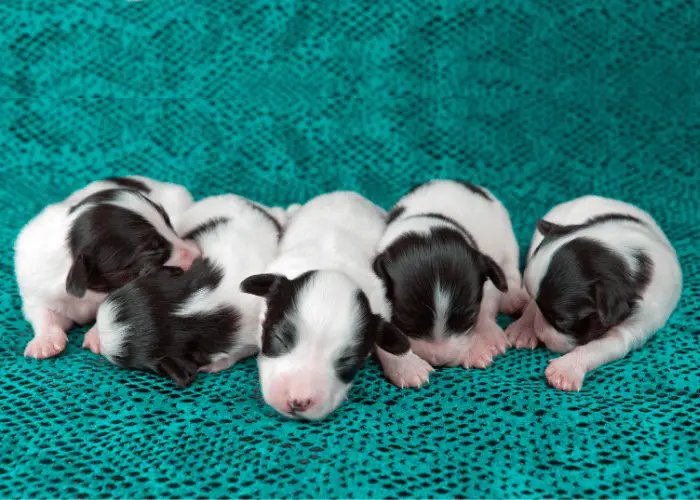
To understand this, we must understand a little bit about how eye color works.
Just like humans, it all starts with genetics. In fact, a dog’s eyes function much like that of ours.
And like our eye color, a dog’s eye color is determined by something called melanin.
For those who aren’t familiar, melanin is a pigment that is not only responsible for eye color, but also for the color of a dog’s coat and skin.

While not true for all dogs, the vast majority of dogs grow to have brown eyes.
Dogs with darker eyes, like brown, have a greater concentration of melanin in their iris.
Dogs with lighter color eyes have a lesser concentration of melanin.
So why the blue eyes at birth?
Simply put, because melanin production doesn’t start right away.
So When Will My Pit Bull’s Eye Color Start To Change?
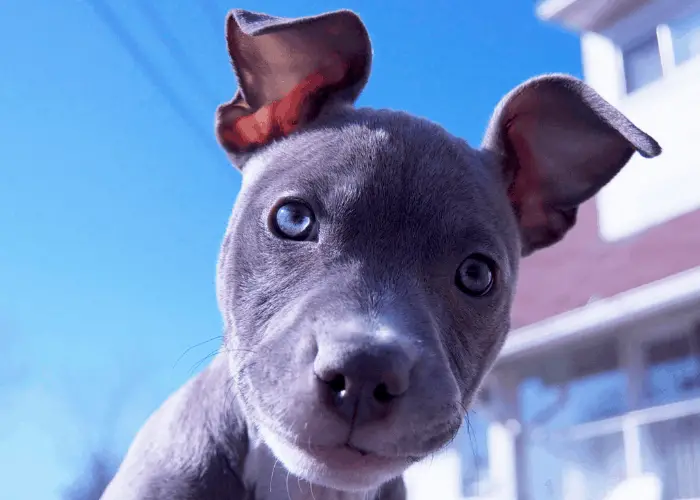
Did you know that a puppy doesn’t even open his eyes for the first 8-14 days after being born?
This means for the first week, or two weeks after birth, we can’t even see the puppies’ eye color!
Research tells us, however, that during this time their entire eye is blue.
In other words, there is no change in color from the iris to the pupil!
Once the dog’s eyes start to open, after about 2 weeks, we can see their beautiful blue eyes.
And the eyes will stay this way until about 3-4 weeks of age when they finally start to change color.
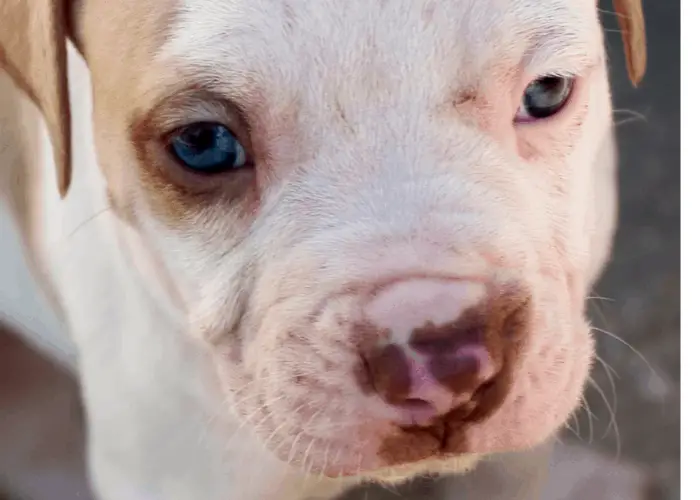
Having said that, we shouldn’t expect that a dog’s eye color would change overnight.
From the beginning, the entire process usually takes about 9-12 weeks.
Some puppies can even take up to 16 weeks before their eye color completely changes over.
So in summary, mostly all Pit Bulls, or even dogs in general, start their life with baby blue eyes.
Some may maintain these eyes throughout their life, but most will darken over time.
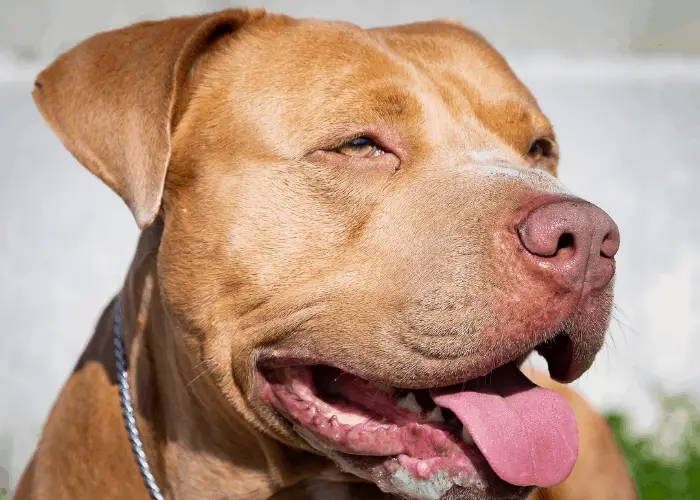
As they mature, most Pit Bulls end up having brown or hazel eyes.
Having said that, while blue-eyed adult Pit Bulls are extremely rare, the idea is not a complete write-off, and they do exist.
The “Blue-Eyed Pit Bull” Argument
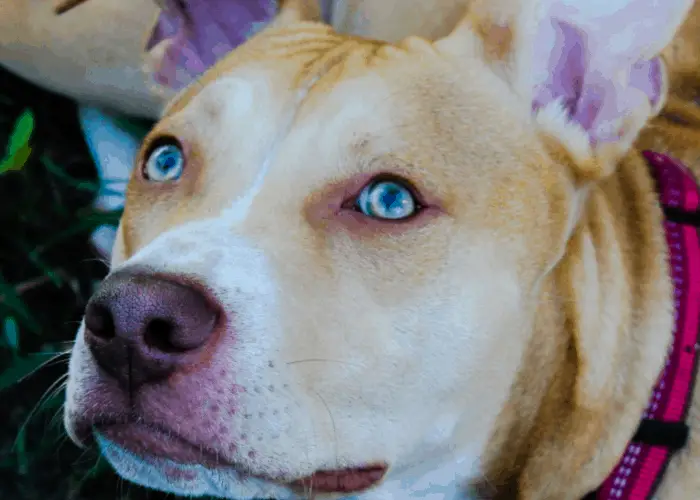
Generally speaking, there are 4 different ways that your Pit bull can end up with blue eyes:
1. They Have The Merle Gene

If you have ever seen a dog with a swirly-whirly coat pattern, they probably have the merle gene.
Coats like this usually have intermixed patchworks of tan, white, and black.
We could get into all of the different DNA facts about merle, but for now, let’s keep it simple.
Just as the merle gene affects the coat pattern, it also affects the color of the eyes and the skin.
Dogs with this pattern of coat often have light blue eyes to go along with it.
It is most common in breeds like Aussies, corgis, and dachshunds.
Can my Pit Bull have the merle gene?
Absolutely. Unfortunately, the idea of breeders specializing in the rare color pattern as stirred up a lot of controversy in the Australian Pit Bull Terrier (A.P.B.T.) community.
This is because it raises the question of a) how it was introduced into the breed, and b) what health problems it could entail for the breed.
In return, the APBT community has recommended that the “merle color be made a disqualification in the APBT breed standard”.
2. They Have A Diluted Pigment Around Their Eyes
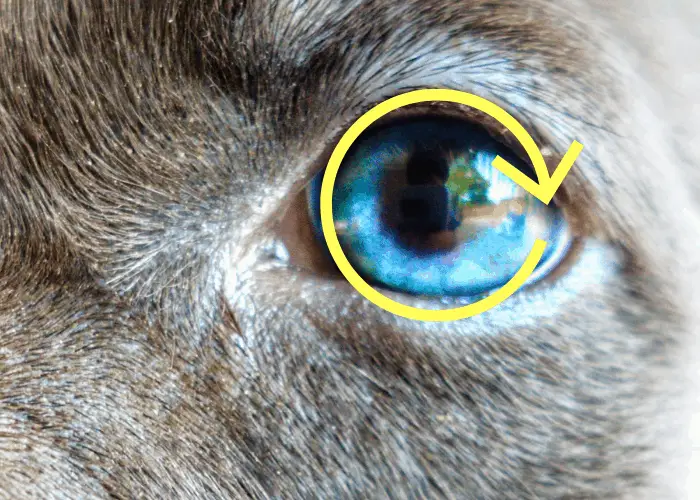
If your dog has a large area of white around one or both eyes, their eyes will probably be blue.
White areas on the dog’s coat means the cells are not able to produce pigment.
When spread to the face, the pigment can be lost around the nose and in the eyes. The result is a pink nose and blue eyes.
To add, lack of pigment doesn’t necessarily occur in both eyes. Rather, it can also occur in just one, making for two different color eyes.
3. Albinism

To find an albino dog is extremely rare. These types of dogs generally have an extremely light coat, a pink nose, and baby blue eyes.
The technical term for this condition is, “tyrosinase-negative”.
What does this even mean?
Remember how we talked about melanin production earlier?
Well, Tyrosinase is an enzyme involved in the production of melanin.
Albino dogs completely lack this enzyme, meaning their body does not produce melanin. This is a recessive gene that is inherited from both parents.
Can Pit Bulls have Albinism?
Yes. With that being said, it is extremely rare. If you do find a dog being sold as a “rare while pit bull”, use caution.
Albinism is often associated with a wide array of health concerns including deafness, blindness, and skin cancers.
In return, reputable and humane breeders generally avoid breeding this type of dog.
4. The Blue Eye Gene (ALX4 Gene)

As we mentioned previously, the blue eye gene is rare in dogs, and Pit Bulls are no exception. (image source)
Pit bulls who are blue-eyed can be the result of this ALX4 gene mutation.
Some dog breeds, like the Siberian husky dogs are more commonly known to possess the dominant blue eye gene .
Other breeds, like beagles and corgis, have a recessive gene marker for blue eyes. This, however, is extremely uncommon.
Why Are Blue-Eyed Pit bull Dogs Considered Undesirable?

It is common to believe that blue-eyed dogs are inherently blind or have extremely poor vision. However, this isn’t always the case, as we’ve discussed with the Husky.
Blue-eyed Pit bull pups who appear to have the merle gene are less desired by purists for fear of the pup not being a purebred, as this condition is introduced outside of the Pit bull breed.
Also, scientists have found that there is a link between blue-eyed Pit bulls and deafness, oddly enough.
This isn’t to say that every blue-eyed Pit bull will suffer hearing loss, but only that the chances are greater than if it were a brown-eyed Pit bull.
Blue-Eyed Pit bull Price

A blue-eyed Pit bull is often more expensive than Pits with more common colored eyes.
That being said, several variables need to be taken into account when a breeder sets pricing. The purity of the bloodlines, for example, make a much heavier-handed difference in price than the dog’s eye color.
A purebred Pit bull from a reputable breeder can already be an expensive dog. A purebred with a strong pedigree will range between thousands and tens of thousands of dollars.
The additional expense of a blue-eyed Pit bull wouldn’t be a dealbreaker for those who already have the money to spend.
If you’re willing to spend the extra money on a blue-eyed Pit, it would be a good idea to work something out with a breeder. If they’re willing, ask them to hold a choice until it’s around 9-12 weeks of age, as that’s when their permanent eye color sets in.
Before that age, making a purchase runs the risk of picking up a pup whose eyes could change from blue to brown 1-4 weeks after you’ve brought it home.
Brown Pit bull with Blue Eyes

As you’ve already learned through this article, blue-eyed Pit bulls are not as rare as many people perceive. Flat out, they’re not all that uncommon, particularly from breeders that are less than careful.
Pits that have health issues due to crossbreeding, breeding merle dogs together, or suffer other deficiencies, are fairly common. These things separate responsible breeders from the less responsible.
But a healthy, purebred Pit bull with a strong colored coat and blue eyes are a rarity. But they do exist!
Because most blue-eyed Pit bulls are merle or low melanin leveled dogs, brown Pit bulls (alongside black, silver, or grey) with blue eyes are extremely rare. These are the dogs who are more expensive than the others.
It’s a rarity because a solid, strong-colored coat is a good sign of proper pigment and melanin levels, thus canceling out both merle and melanin deficiency as the reason.
Where to Find Pit Bulls with Blue Eyes for Sale

Unfortunately for the breed, the first place you should look would be a kennel, ASPCA, Pit bull rescue shelters, and the like.
The reason- Some folks have a certain type of dog in mind when they pick up a Pit bull. As soon as they find that they’re much more work than originally bargained for, they get rid of them. It happens all the time.
As far as selecting a breeder goes, find one that will give you references and show you AKC paperwork to prove the parents’ pedigree.
If you find a breeder selling any dog, but particularly blue-eyed Pit bulls at a relatively low price, do your best to figure out why.
Because they feel like they can get a few extra bucks for the blue-eyed variety, bad breeders won’t have a problem doing all the wrong things to make it happen.
Conclusion:
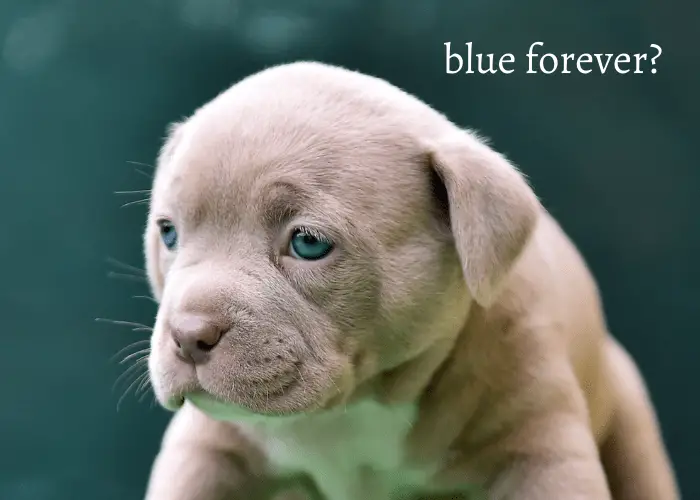
So will your Pit Bull puppies eyes stay blue forever? They could, but it’s highly unlikely.
Enjoy your puppies bright blue eyes while they last, and embrace the beautiful brown or green eyes that develop – they are the windows to your Pitties soul.

